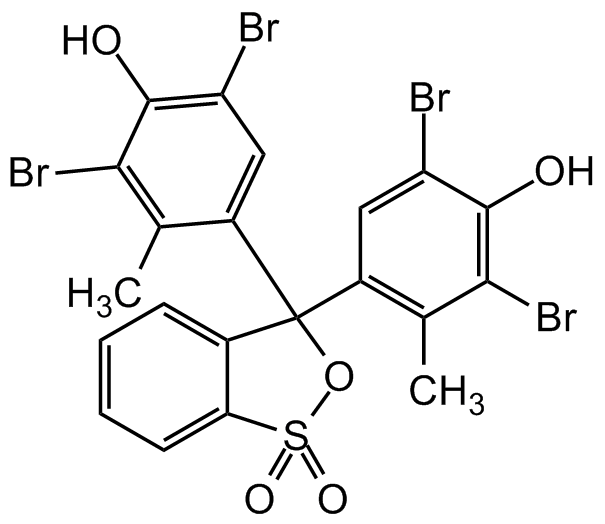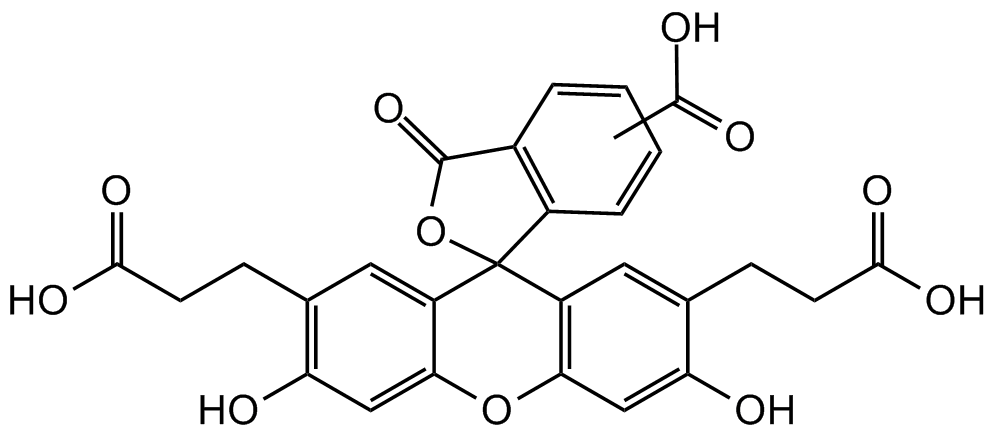
Chemical Structure
Bromocresol Green
CDX-B0264
CAS Number76-60-8
Product group Chemicals
Estimated Purity>95%
Molecular Weight698.01
Overview
- SupplierChemodex
- Product NameBromocresol Green
- Delivery Days Customer10
- CAS Number76-60-8
- CertificationResearch Use Only
- Estimated Purity>95%
- Molecular FormulaC21H14Br4O5S
- Molecular Weight698.01
- Scientific DescriptionBromocresol green (BCG) is a pH sensitive triphenylmethane dye useful in a variety of colorimetric detection technologies. BCG is used as a tracking dye for DNA agarose gel electrophoresis, in protein determinations and in charge-transfer complexation processes. In TLC BCG is used for visualization of the compounds with functional groups whose pKa is below 5.0. One major use is to measure serum albumin concentration within mammalian blood samples in possible cases of kidney failure and liver disease. In aqueous solution, bromocresol green will ionize to give the monoanionic form (yellow), that further deprotonates at higher pH to give the dianionic form (blue). Visual transition interval: pH 3.8 (yellow) - 5.4 (blue). UV-Visible (lambdamax): 423 nm, 444 nm, 617 nm. Bromocresol green is also an inhibitor of prostaglandin uptake that blocks the immediate rise in intracellular immunoreactive PGE2 following treatment with 16,16-dimethyl-PGE2. Bromocresol green prevents the stimulatory effect of 16,16-dimethyl-PGE on cell proliferation, adhesion, migration and invasion and on HIF-1alpha expression and activity. Additional applications include use in sol-gel matrices and the detection of ammonia. - Chemical. CAS: 76-60-8. Formula: C21H14Br4O5S. MW: 698.01. Bromocresol green (BCG) is a pH sensitive triphenylmethane dye useful in a variety of colorimetric detection technologies. BCG is used as a tracking dye for DNA agarose gel electrophoresis, in protein determinations and in charge-transfer complexation processes. In TLC BCG is used for visualization of the compounds with functional groups whose pKa is below 5.0. One major use is to measure serum albumin concentration within mammalian blood samples in possible cases of kidney failure and liver disease. In aqueous solution, bromocresol green will ionize to give the monoanionic form (yellow), that further deprotonates at higher pH to give the dianionic form (blue). Visual transition interval: pH 3.8 (yellow) - 5.4 (blue). UV-Visible (lambdamax): 423 nm, 444 nm, 617 nm. Bromocresol green is also an inhibitor of prostaglandin uptake that blocks the immediate rise in intracellular immunoreactive PGE2 following treatment with 16,16-dimethyl-PGE2. Bromocresol green prevents the stimulatory effect of 16,16-dimethyl-PGE on cell proliferation, adhesion, migration and invasion and on HIF-1alpha expression and activity. Additional applications include use in sol-gel matrices and the detection of ammonia.
- SMILESO=S1(C2=CC=CC=C2C(C3=CC(Br)=C(O)C(Br)=C3C)(C4=C(C)C(Br)=C(O)C(Br)=C4)O1)=O
- Storage InstructionRT
- UNSPSC41116134



![Bromocresol green [76-60-8]](https://www.targetmol.com/group3/M00/02/DF/CgoaEWY7OuOEUCE2AAAAAKiHKnU737.png)